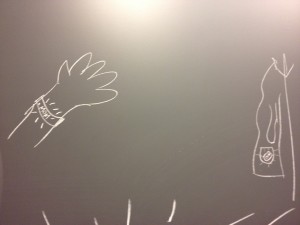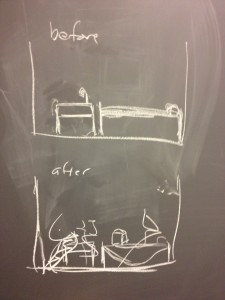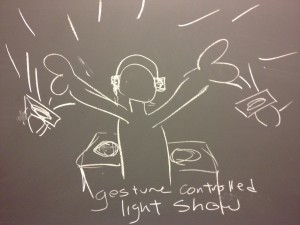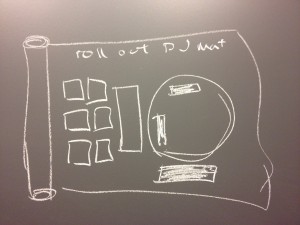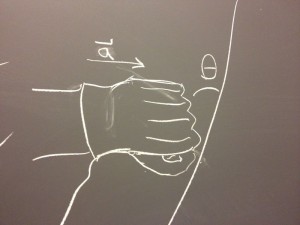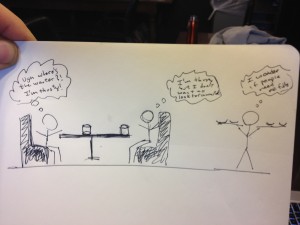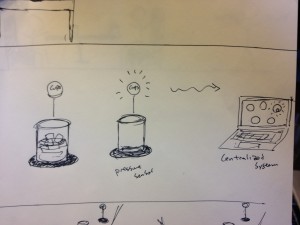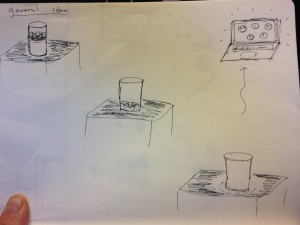Group
- Avneesh Sarwate (asarwate@)
- John Subosits (subosits@)
- Joe Turchiano (jturchia@)
- Kuni Nagakura (nagakura@)
- Yaared Al-Mehairi (kyal@)
Brainstorming List
- Spare Prox/Key Shooter (SPK) – SPK shoots a spare prox or key under your door when triggered by an iPhone.
- hiLight – A highlighter that reads text that you highlight and stores it on your computer.
- Snoozy – An alarm clock that uses motion sensors for snoozing capabilities (helps you control an alarm clock that is out of reach).
- MotherClocker – An alarm clock that senses if you’re levels of motion (e.g. stirring or dead silent) and adjusts volume accordingly.
- myBar – An interactive bar counter that lights up when you want a drink and visually notifies the bartender (kind of like in airplanes).
- hiRoom – A system that tracks motion and heat in rooms and keeps track of the availability of rooms.
- HandBoard – A new type of extended keyboard that makes full use of gesture control.
- AbsolutelyRotten! – An alarm that detects rotten food in your fridge.
- MatchFit – A color sensing camera app that detects if your clothes match or not.
- HowToDressWell – An application that learns your fashion tastes and sensibilities.
- GComp – An immersive gesture control computer.
- GTV – An immersive gesture control TV.
- Grillo – A streamlined, interactive grill ordering system for Terrace/Tower that also tells you what orders have finished being prepared.
- PencilMouse – Pencil shaped mouse that you can use on your screen.
- HotDamn! – Heat sensor that notifies when you’re overheating or sweating in formalwear.
- mobPage – Pager for smartphone that notifies if a special person is trying to contact you (sketch below).
- myMix – A system that makes your mixed drink.
- ArchScan – A scanner for 3D prototypes that translates them into CAD or Rhino.
- Tabelisk – A desk that incorporates a tablet computer.
- PetPet – A pet feeder that can feed your pets on a timer or detect when they approach.
- Scarecrow – Scarecrow that senses unwanted animals and scares them off.
- SketchIt – Etch-a-sketch controller/app that works on computers.
- PubPort – Interactive system for optimizing public transportation hubs/stations.
- MCVolume – Motion-controlled volume controller (possibly for TV).
- Rise – Light-sensor alarm clock that wakes you up when the sun comes up.
- DrinkUp – A system that uses pressure sensors to detect when your drink is empty and notifies the bartender/waiter to get a new one.
- EyeComp – Eyepiece computer with facial expression and voice recognition software.
- DifPic – A camera that compares a picture of your room to a picture of it when clean (sketch below).
- E-Cig – An electronic cigarette measuring smoke throughput that gives you your stats.
- GGPS – A GPS system that notifies trafic patterns and indicates most efficient routes.
- UrbOp – An urban system in which road and street sensors optimize traffic lights.
- CarMap – A density map that shows you where cars are in a selected area.
- Radar – Laser tag radar system with map (kind of like how video games display enemy position).
- Empto – System for detecting decreasing drinks in restaurants.
- DJ Light – A gesture controlled light show that allows DJs to use their movements for a light show (sketch below).
- MIDI Light – A system that allows DJs to have a MIDI controlled light show.
- Sound Light – A system that allows DJs to have a live-sound controlled light show.
- Gestar – An enhanced guitar incorporating extra sensors to trigger effects without extra gestures.
- DJ Mat – Rollout DJ mat that uses smaller sensors instead of big 3D hardware (sketch below).
- MoodMix – A song mixer that plays music depending on mood lighting, temperature, and room humidity.
- Posturrector – A posture correcting system that beeps when you slouch.
- SenseForm – A mechanism that assesses the form of your squats/lifts against ideal static finish positions using flex sensors (or Kinect).
- PressBox – A box squat device with pressure sensors to stop you from cheating (i.e. sitting on the box).
- Juggo – Learn how to juggle a soccer ball using Kinect.
- GloveForm – Martial arts glove that teaches proper form by detecting hit knuckles and wrist angle (sketch below).
- ForceForm – Force/accuracy sensor to determine the effectiveness of your punch/kick on a bag.
- MemPic – A smartphone app for students (mostly freshman) that can take pictures of buildings and know their campus location and department/facility associations.
- VirtualNote – A system that incorporates a pencil that integrates handwritten notes to a virtual notepad (so it is okay to lose your hard copy).
- JuggoMotion – Special juggling balls that teach you how to juggle by displaying the motion of the balls on the screen.
- MindMouse – A mind-controlled mouse, using EEG caps that measure brain waves.
- EnviroSense – An environment (e.g. room) with sensors that measure your sweat and body temperature and adjusts the humidity and temperature of the room accordingly.
Idea Choice
Prime Ideas
- DrinkUp (#26)
- SenseForm (#42)
- VirtualNote (#48)
- DJ Light (#35)
Our first choice for ideas (non-Kinect based) is DrinkUp – a system that notifies staff, waiters, and bartenders in a bar or restaurant if a customer’s drink needs to be refilled. Our second choice for ideas (Kinect based) is SenseForm – a system that serves as a personal weight-lifting trainer that makes use of Kinect to direct and teach users how to properly lift weights. These ideas have clearly defined problems and the ideas in themselves are not overly complicated, therefore leading to simple solutions. Below we expand on both of these ideas (however we have left out designs and sketches for our second choice).
DrinkUp: Idea #1
Target User Group
The target user groups for this technology are both patrons and staff of restaurants, bars, or virtually any other establishment where a drink might be served. The idea driving our project is to remove any active participation on the part of the patron for requesting refills. We imagine the drink and table sensors being used by patrons, who might want to let their waiter know they need a refill on their drink, or by the waiters themselves, who might want to keep track of all the drinks in the restaurant and refill them when they are empty.
Problem Description and Context
Imagine yourself in a crowded bar or restaurant. You’ve just finished your drink of choice, and your glass is now empty. However, you are still eating food of some sort, or perhaps for some reason you are just very thirsty today. Maybe you’re enjoying a conversation with a friend or a colleague and you can’t be bothered to scan the restaurant for a waiter. Unfortunately, no matter what you do, you’re having difficulty getting a refill! Maybe the bartender is at the other end of the bar at the moment and well-occupied, or perhaps your waiter at the restaurant is just nowhere to be seen. Has this ever happened to you? Our system will let you stay “in the moment” with whatever is engaging you at your eatery of choice, and stop service lags from breaking your flow of conversation. Experience the restaurant as it should be.
Justification of Technology Platform
Fear not! Imagine this scenario: there is a small touchpad on your table/bar seat. When you tap the touchpad, it sends a signal to the restaurant staff or the bartender to let them know that you’d like a refill for your drink! But let’s say that the restaurant is crowded at the moment. Even if the waiters wanted to come by and refill your drink, they are just too busy to do so. Well, it just so happens that in addition to that manual touch sensor on your table, there is a pressure sensor directly underneath your cup. This pressure sensor took note of when your drink was full, and it’s able to tell when the weight of your cup has decreased enough for it to be empty. When it detects that your cup is empty, it automatically sends a signal to the staff to let them know – and the staff maintains a computerized list of which cups in the restaurant are empty at the moment. Now the restaurant staff has a more effective method of managing empty drinks, and as a result you get yours refilled within moments rather than having to wait as long as a half hour for a waiter to notice your empty glass!
Our system is arduino-based, making use of pressure sensors to detect whether a glass is full or not, and then sending the table location to the staff computer. The system needs to be portable to accommodate different table locations as well as be able to interpret the data returned from a pressure sensor, so the arduino is ideal for that purpose. In order to actually be useful, the data must then be sent to a central location, which is why a computer application is necessary.
Designs and Sketches
SenseForm: Idea #2
Target User Group
This project is targeted towards anyone performing standard power lifting lifts in the gym. It will work best for lifts that have a static final position (i.e., the low-holding position in a squat). The system will tell them if they are performing the lift properly or not.
Problem Description and Context
Often, when people go to the gym to lift, they have a “gym buddy” that they can go with, one who can watch them and tell them if they are properly performing the lifts. For power lifting lifts in particular, the technique of the lift is of utmost importance. If a person goes to the gym alone, it becomes difficult to effectively determine whether one is correctly performing a lift or not. Mirrors are sometimes not available, and even when they are it is difficult to properly evaluate your form simply from a mirror view. This system could help alleviate that problem.
Justification of Technology Platform
A kinect, wekinator, and a laptop could be used to implement this system. The user could hold the final position and use these training examples to train the “finished” position on the wekinator, and then go through the motions before finishing and use these examples to train the “not finished” positions. The kinect’s skeletal tracking would be ideal for sensing the body positions. A simple footswitch could be used to turn example selection from the kinect on or off.

